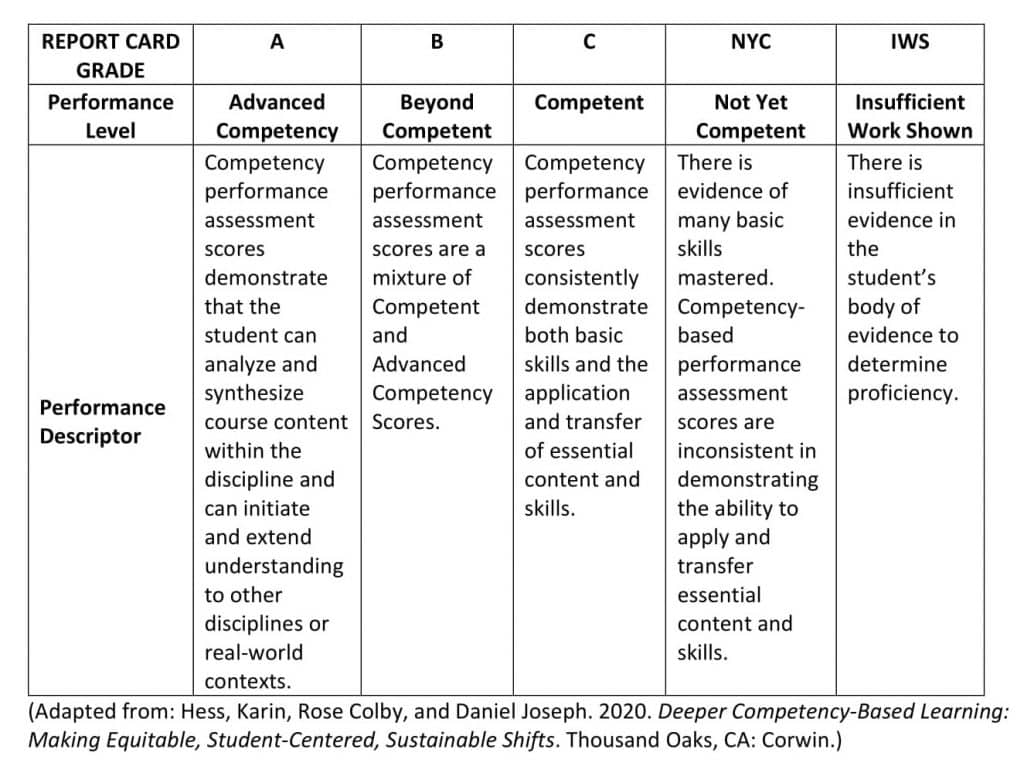Building Coherent Grading and Reporting Systems in Competency-Based Education, Part 1
CompetencyWorks Blog

This is the first post in a guest series. Links to the other posts are at the end of this article.
As educators move to competency-based designs in teaching and assessment, they often realize that their traditional or standards-based grading approaches are inadequate in communicating student learning. These limitations include that students have minimal incentive or opportunity to improve their learning after grades are issued, students can earn passing grades even without substantive learning, and academic and personal performance are combined into a single grade.
It is important to begin grading reform work with some important design features to avoid some of the pitfalls in grading reform that can be difficult and unpleasant. First, it is important to consider that moving to competency-based grading is a system-wide change. Consider your learners and the walk they will take for up to twelve years in their learning within your system. There must be a concerted effort for each school and teacher to communicate the learning journey using the same criteria. The magnitude of this work can be overwhelming but creating a multi-year process to create systemic coherence is meaningful work.
Let’s begin with the Profile of your Graduate. This work is essential in shaping the teaching and learning opportunities K-12 and it is our obligation as educators to communicate the body of evidence that demonstrates a student is ready for the handshake at graduation. In working backward from graduation, how will you create a coherent continuum of learning and assessment that yields the body of evidence? In communicating this body of evidence throughout the K-12 learning experience, we must consider fair and equitable grading by all K-12 teachers.
Stripping the inequity out of traditional grading practices is essential. The process of undertaking grading changes must have a few ground rules and equity should be at the core of school policies and teacher practices. The reality is that grading is a very personal teaching activity. For better or worse, each teacher’s approach to grading generally differs from teacher to teacher. Therefore, in undertaking grading changes, we must approach these changes with the principles of fairness and equity[1]. The best practices in standards-based grading are a good starting point to move to competency-based grading. However, there is quite a bit of development work in competency-based learning and assessment that must be foundational before going public with a new grading system.
The first in this three-part series on competency-based grading will focus on establishing a roadmap to a new grade reporting system that focuses on the strong underpinnings of high quality academic and personal competencies, assessment systems, and grading policies:
- Academic Competencies and Personal Success Skills: Create high-level academic competencies K-12 in all disciplines as well as the personal success skills aligned to your profile of the graduate.
- Create Essential Standards That Support the Academic Competencies: These essential standards reduce the number of standards generally found in most curricula. These standards are incorporated into units of study. Each unit of study should identify which competencies are at play within the unit. This mapping allows teachers to determine how often competencies are addressed across the curriculum. The mapping should uncover redundancies and gaps in addressing competencies needed in the continuum to graduation.
- Design a Holistic Proficiency Scale: This scale is essential in defining the criteria for proficiency/competency and forms the design elements for teacher-created rubrics guiding student products within units of study. Consider this sample scale as the bridge between a grading system and teacher assessment and grading practices:
 Performance Task Rubrics: Performance tasks are scored on rubrics customized to the performance descriptors in the Holistic Proficiency Scale. This really creates the coherence in all teachers assessing Competency/Proficiency using the same criteria in the summative declaration of a student’s learning.
Performance Task Rubrics: Performance tasks are scored on rubrics customized to the performance descriptors in the Holistic Proficiency Scale. This really creates the coherence in all teachers assessing Competency/Proficiency using the same criteria in the summative declaration of a student’s learning.
- Personal Success Skills: These are identified within the performance tasks, separate from academic competencies but assessed by the student as part of their metacognition and personal goal-setting and reported out separately.
As you can see, there is quite a lot to consider when undertaking grading reform. The work need not be sequential as you may have many pieces already in place. However, grading reform must be based on high-quality instructional design and assessment. There are many avenues to support professional learning to support this and for this reason, creating a timeline for grade reform must include the best supports possible for teachers to learn and apply new concepts of teaching and learning in competency-based learning.
The next article in this series on grading reform will describe the specific school-wide policy considerations and the changes in teacher grading practices that should be considered when designing competency-based grading systems. The third and final article in the series will provide a list of grading reform resources.
Learn More
- Building Coherent Grading and Reporting Systems in Competency-Based Education, Part 2
- Building Coherent Grading and Reporting Systems in Competency-Based Education, Part 3
- AASA Explores Competency-Based Education Grading
- Progress and Proficiency: Redesigning Grading for Competency Education
- Five Obstacles to Grading Reform
Rose Colby is the author of Competency-Based Education: A New Architecture for K-12 Schooling, 2017, Cambridge: Harvard Education Press; and co-author of Deeper Competency-Based Learning: Making Equitable, Student-Centered, Sustainable Shifts, by Karin Hess, Rose Colby, and Daniel Joseph, 2020 (in print). Thousand Oaks, CA: Corwin. Rose can be reached at [email protected].
[1] Feldman, Joe. 2018. Grading for Equity. Thousand Oaks, CA: Corwin.